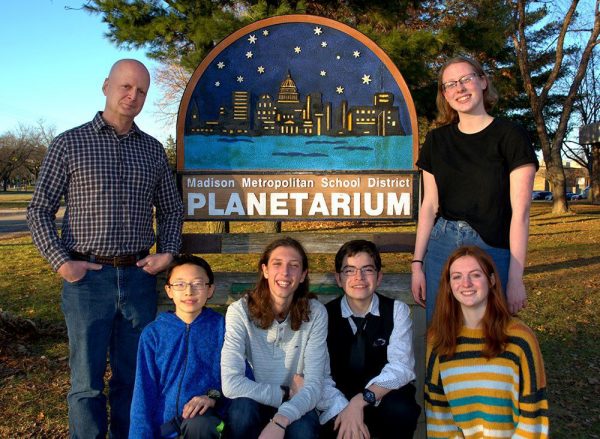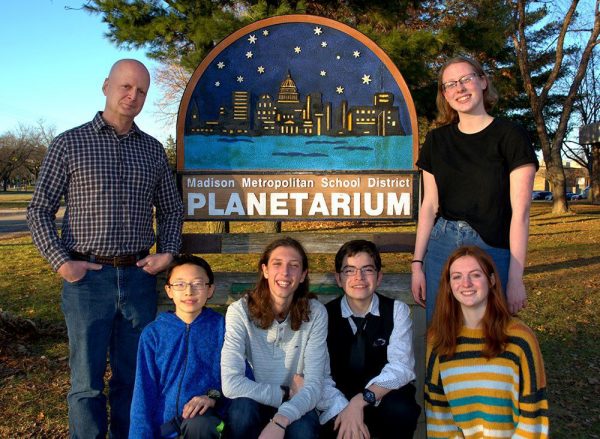A group of Madison Memorial High School students will be among the stars of the astronomy world early next year.
Reaching for the stars: Memorial High School group to present astronomy research in Hawaii in January – Madison.com
Reaching for the stars: Memorial High School group to present astronomy research in Hawaii in January

From left, Planetarium director Geoff Holt, Memorial sophomores Kyle Ma, Isaac Levenstein and Andres Perez and seniors Tessa Mehnert and Sophia Schmitz. The group will travel to Hawaii next month to present research at an American Astronomical Society meeting.
Scott Girard
After months of research on the debris surrounding distant stars, the group, which also includes Madison Metropolitan School District planetarium director Geoff Holt, will present its findings at the American Astronomical Society meeting in Hawaii.
The group is made up of sophomores Kyle Ma, Andres Perez and Isaac Levenstein and seniors Sophia Schmitz and Tessa Mehnert. Kyle will not be able to attend the Hawaii trip, but the others will visit the state for the conference Jan. 3-8. Holt said they’re going one day early to see some of the sights, but the rest of the trip will be inside a convention center among graduate students and Ph.D. candidates in astronomy.
Holt applied to NITARP, the NASA/IPAC Teacher Archive Research Program, in 2018, not knowing at the time if he would involve students in the research ahead. The program helps astronomy teachers around the United States do research in the subject and then pass along what’s learned to their students.
In March 2019, though, after a few virtual meetings with the astronomer consulting on the project along with two teachers from other states, he decided to offer an open invitation to the Memorial astronomy club. Isaac took him up on the offer immediately, participating in a group meeting that afternoon.
“For the most part I was just sitting trying to figure out the words they were saying,” the student said of listening on that day. “Then it just sort of became a thing every Tuesday after school, I’d swing by, watch the virtual meeting, digest some information and then eventually sort of come to an understanding of what we were doing.”
It wasn’t the trip to Hawaii that kept Isaac coming to the meetings. Holt avoided telling students about the potential travel to make sure any students who signed up were interested in the research part, given how much work he knew would be required. Instead, Isaac found himself fascinated by things he didn’t know but had an unexpected opportunity to learn.
The other four joined later in the year as they heard about the project, and have been using a European galaxy mapping database ever since to study debris around stars in the Milky Way galaxy using the light emitted from the stars and measuring if it’s re-emitted by dust particles that might be surrounding them.
“I was like, ‘research, NASA — why would I say no?’” Tessa recalled of joining the effort. “For me, the coolest part has been getting to do actual research.”
Sitting in the school’s planetarium Dec. 9, Holt explained he heard about NITARP through friends in the planetarium world who had participated in the past and encouraged him to submit a proposal. The first half of the 2019 calendar year for which the program was running was spent mostly learning about astronomy. Holt recalled reading short papers — three or four pages long — that would take “four to six hours in order to understand” given the technical language involved.
“It’s been a great process to learn how astronomy is done in actual research,” he said. “I am no longer as intimidated by going into actually reading the original published paper as opposed to the astronomy magazine interpretation of that paper.”
Quickly, it was Holt and then the students that had to explain the papers they were reading, which was a valuable exercise in learning how to interpret what they were reading and figure out what was worth highlighting. It’s a skill they’ll put to use at the conference next month as they present their research results and findings.
They anticipate plenty of questions.
“That part’s going to be really cool,” Tessa said. “They’ll be asking questions that maybe we didn’t think about or maybe we did and we’ll be able to answer them and be like, ‘This is what we did and this is why we did it and why our research matters.’”
Isaac expressed appreciation for Holt involving students, a choice that “has bettered our lives a ton,” and is excited to see their work of nearly a year come to fruition.
“It coming to a close is going to be really satisfying,” he said. “From having no understanding, to having a little bit, to doing our research and visually vetting all these sources and making diagrams and figuring out how we’re going to research things, all to finally release it on the world is going to be really, really satisfying.”
Plus, they’ll be among a pretty interesting crowd.
“I also want to meet some astrophysicists,” said Andres, laughing. “I really want to ask them some questions.”
Share your opinion on this topic by sending a letter to the editor to tctvoice@madison.com. Include your full name, hometown and phone number. Your name and town will be published. The phone number is for verification purposes only. Please keep your letter to 250 words or less.











